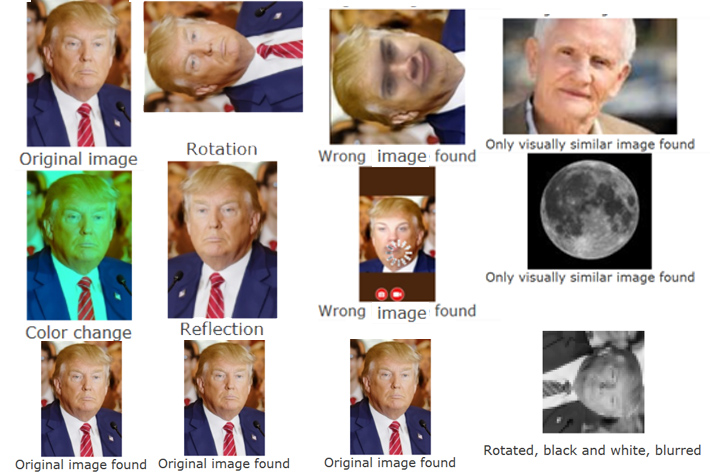
The new program developed by the German company IM&P takes the protection of images online a step further but, says the developer, also helps to fight fake news.
It’s another step forward in terms of copyright protection and, according to the company behind the algorithm, a revolution in reverse image research. The new program, announced and demonstrated at CeBIT 2017, was successfully tested, according to IM&P’s report: it can find original images, “but also also very changed images on the Internet.”
The company made a proof of concept based on a test image, using Donald Trump, which was distributed with the press-release, but invites those interested to contact them in order to test the software online, free of charge.
Our enhanced Reverse Image Search (eRIS) software solution, says Indalyz Monitoring & Prognostics, “locates in the internet duplicates and also changed images deviating from the original image by symmetry operations (rotations, reflections), affine compressions, colour changes and also dilations. Our software product consists of an investigation module and a research module, which are both based on a fast algorithm for image characterization. The algorithm is based on structural signatures that are to be understood as a kind of fingerprint of the image content. Formally, the underlying algorithm consists of 21984 different signature configurations allowing a very good differentiation of different images.
Even through image compression, affine image deformation, uniform changes, rotations and reflections “the signatures remain unchanged”, adds the company. However, due to a recalculation of the colour values of each pixel, by scaling and saturation effects or by complex changes in the colour structure the signature can be weakly distorted. Therefore, the original image and the modified/changed image will be considered to be identical if their signatures are adjacent.
The software product can be applied to
- …… enhance the reverse image search
- … assist in finding the violation of image rights
- … verify images in false reports (fake news) on social media
The software product offers the following USPs:
- … increased quality and efficiency compared with methods of market leaders
- … high speed due to an efficiently storing of image signatures in databases
- … recognizes images despite changes
Image theft happens everywhere and is a problem for photographers. According to data from the online portal Copytrack, “China provides the highest number of cases in copyright infringement of digital images in 2016 with 11 percent. France and the United States rank second and third.”
Copytrack, which is specialized in browsing the Internet worldwide for unauthorized image use and in re-licensing those findings for photographers, picture agencies, news agencies, publishers as well as e-commerce providers, analyzed 10,000 randomly selected cases dating from 2016 in its database in order to find ten countries with the highest rate of copyright infringements.
In 2016, Copytrack traced the most frequent copyright infringements in China (11.11%), France (9.53%) and the US (8.21%). The runners up on this point of image theft are Turkey (4.65%), Russia (4.57%), the United Arab Emirates (4.55%) and Spain (3.47%). Ukraine (2.85 percent), the Netherlands (2.72%) and Italy (2.68%) make up the bottom of the top ten.
“Most of our customers are very surprised where we find their images used illegally”, says Copytrack CEO Marcus Schmitt. “Image theft occurs everywhere and is committed by private people, bloggers, magazines and companies. Obviously in some countries, the creative property of others is less respected”, adds Schmitt.
For Copytrack, it is unimportant where an image theft took place. If requested by customers, the company gets active worldwide and demands subsequent payments in 140 countries. 35 percent of all cases are settled after a simple request for payment by Copytrack. The average value of images re-licensing is 694 euro. Another 55 percent of all cases are paid after claim enforcement. On average, Copytrack obtained a total of 1430 euro.
Schmitt aims at a cost-efficient and fair post-licensing for the user which tends to result in further business relations between image owner and former image thieves. Copytrack carries the entire cost risk of its customers, including all legal proceedings. The service is free of charge. In case of success, Copytrack receives a commission of 30% whereas 70% of the sum obtained will be transferred to the copyright owner. The values, and that’s an interesting note to end this article, are similar to those an agency pays to its photographers.
